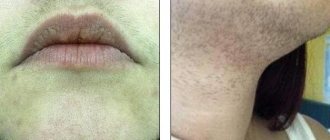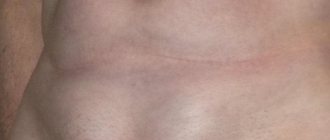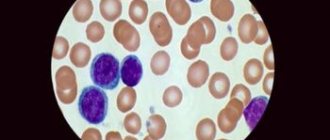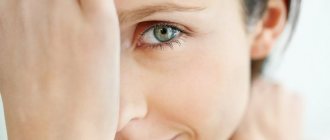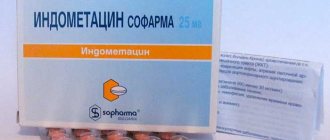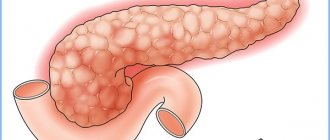Escherichia coli is a type of enterobacteria that inhabits the mucous membranes of the gastrointestinal tract of humans and warm-blooded animals. Escherichia coli is a gram-negative bacteria, that is, it does not turn red or pink when placed in a safranin solution due to the fact that it has an outer cell membrane that prevents the penetration of the dye. Normally, E. Coli is not harmful to human health and is a normal inhabitant of the intestinal microflora, but when the body’s resistance decreases, dangerous strains can be released that can cause severe food poisoning and toxic infections.
The most studied species of Escherichia is Escherichia coli, also called Escherichia coli.
When cases of infection with this type of bacteria are detected, preschool educational institutions are closed for quarantine.
E. coli - main symptoms
Signs of a classic E. coli intestinal infection usually develop three or four days after exposure to the bacteria. Patients report watery diarrhea, dehydration, abdominal cramps, and abdominal pain or tenderness.
Nausea and vomiting occur only in some people. Fever is usually accompanied by bloody diarrhea and dehydration. The intestinal mucosa is significantly inflamed.
Manifestations can range from asymptomatic to watery diarrhea and bloody diarrhea, renal failure, microangiopathic hemolytic anemia, thrombocytopenia and signs of central nervous system damage.
Patients with Escherichia cholecystitis or cholangitis complain of pain in the right upper quadrant of the abdomen, fever and jaundice. In severe cases, hypotension and neuropsychiatric disorders also develop.
You can get rid of such signs of the disease only under the full supervision of a doctor. Cholecystitis manifests as fever (> 39°C), chills, and may be complicated by a liver abscess.
Patients with intra-abdominal abscesses caused by E. coli may have an elevated body temperature. The spectrum of clinical manifestations ranges from nonspecific findings on abdominal examination to frank septic shock.
People with Escherichia pneumonia usually have fever, shortness of breath, increased respiratory rate, and increased mucus in the bronchi.
www.mayoclinic.org
emedicine.medscape.com
Diet during treatment
During the period of acute intestinal infection, adherence to a gentle diet is indicated. Fried, spicy, fatty foods, as well as pickled and canned foods are completely excluded from the patient's diet. Before recovery, you must give up dairy and fermented milk products, since milk sugar is an excellent nutrient medium for E. coli.
Fruits and vegetables should be consumed pureed or baked. This is necessary to prevent injury to the inflamed intestinal mucosa by coarse dietary fiber, which is contained in large quantities in this group of products.
Baked apples
The following dishes and products are also prohibited:
- seeds and nuts;
- carbonated drinks;
- chocolate and products containing cocoa butter;
- confectionery;
- alcohol;
- sausages;
- salo;
- butter;
- canned fish and meat.
Preservation for the period of treatment is prohibited
It is necessary to adhere to a gentle diet for at least 10 days.
Escherichia coli is a natural inhabitant of the human body, but if hygiene rules are not followed and the immune system is systemically weakened, infection with pathogenic strains of Escherichia coli is possible, which can cause severe diseases of the intestines and other internal organs. Prevention of infection consists of improving personal hygiene skills, proper food processing and strengthening the body's protective functions. Itching of the anus, you can find out at the link.
What is this pathology?
Escherichia coli bacteria usually live in the intestines of healthy people and animals. They are part of the normal microflora, the main facultative inhabitant of the large intestine.
The genus of microorganisms is named after Theodor Escherich, the physician who first described Escherichia coli. The bacteria are gram-negative bacilli that exist singly or in pairs.
E. coli are facultative anaerobes with a type of metabolism that is both enzymatic (fermentation in the absence of oxygen) and oxidative. They either do not have the ability to move, or are mobile due to the presence of flagella.
Most varieties (serotypes, strains) are harmless or cause relatively short-lived diarrhea. But some aggressive subtypes, such as E. Coli O157:H7, can cause severe abdominal cramps, bloody stools, and vomiting.
These organisms are one of the most common causes of many common bacterial infections, including cholecystitis, bacteremia, cholangitis, urinary tract infection and traveler's diarrhea, as well as other clinical infections such as neonatal meningitis and pneumonia.
www.mayoclinic.org
emedicine.medscape.com
Escherichia coli: what is it?
The gram-negative bacteria E. Coli (Escherichia coli) belongs to the Enterobacteriaceae family, along with Plague Bacillus and Salmonella. They are rod-shaped and their size reaches 1-5 microns. E. coli was first discovered and described by the German pediatrician Escherich at the end of the nineteenth century, after whom the genus Escherichia was named. During its life, Escherichia coli produces various substances and compounds that can affect the functioning of the digestive tract, for example, ethanol, carbon dioxide, acetate, etc. If E. Coli colonies begin to grow rapidly, the level of these substances increases, which can cause fatal intoxication in infants, the elderly, and patients with various forms of immunodeficiency and immunosuppression.
Gram-negative bacteria E. Coli
Some strains (groups of individuals with identical properties and functions within the same family) of Escherichia coli have flagella at the end, which allows them to move and bind to low molecular weight carbohydrates due to the protein located at the end of the flagella. The ability to move is the main pathogenetic factor in the spread of infection beyond the gastrointestinal tract. The most dangerous form of escherichiosis (infection caused by bacteria of the genus Escherichia) is meningitis. This is a pathology with a high risk of mortality, so patients with this disease are treated exclusively in a hospital setting.
Harm to a person
Note! Escherichia coli is one of the few types of bacteria that can grow and reproduce at high temperatures. Some strains of Escherichia coli retain their vital activity even at 48-50°C, and the optimal temperature for reproduction is 37°C. For this reason, antipyretic drugs for diagnosed E. coli infection must be given before the temperature rises to the upper limit of low-grade fever.
Effective treatment - how to get rid of E. coli
How to get rid of E. coli? The extent of medical care depends on the severity of the infection. In addition to antibiotics, supportive care should be provided: fluid replacement, adequate oxygenation (treating E. coli with oxygen), and blood pressure support if required. Surgical debridement may be performed in patients with intra-abdominal abscess, cholecystitis, or cholangitis.
Meningitis requires antibiotics such as third-generation cephalosporins (eg, ceftriaxone).
Escherichia pneumonia requires respiratory support (supply of a humidified oxygen mixture) and antibacterial drugs (fluoroquinolones).
Cholecystitis and cholangitis require antibiotics such as third generation cephalosporins. For intra-abdominal abscess, antimicrobial agents should also include: ampicillin and sulbactam or cefoxitin. For severe infections, piperacillin tazobactam, imipenem-cilastatin, or meropenem may be used.
Intestinal Escherichia infections require replacement therapy - parenteral administration of fluid solutions containing the necessary electrolytes. Antibiotics include doxycycline, trimethoprim, fluoroquinolones, and rifaximin. They reduce the duration of diarrhea by 24-36 hours.
Patients with concomitant diseases (for example, diabetes) should take a course of levofloxacin or aztreonam for 7-14 days.
emedicine.medscape.com
E. coli in adult stool
Typically, diarrhea indicates that pathogenic E. coli has appeared in the intestines. An adult can become infected with this infection while traveling to countries where the level of hygiene is low. Poorly processed meat, fish and dairy products can also cause intestinal problems. The patient's absorption of toxins increases, which causes weakness and fatigue. When a sick person comes to the clinic, the doctor prescribes a test for dysbacteriosis. Testing for bacteria is always carried out before prescribing a course of antibiotics. The norm for an adult in the analysis of E. coli stool for dysbacteriosis is 10*6–10*8 CFU/g.
How the virus is transmitted
How is E. coli transmitted? Among the many Escherichia strains, only serotype O157:H7 produces a powerful toxin that damages the intestinal lining, which can cause bloody diarrhea. The infection develops when a bacterium is swallowed, and a small number of microorganisms is sufficient for this.
The most common way to become infected with E. coli is by eating contaminated food:
- Ground beef. When cattle are slaughtered and processed, bacteria from the intestines can transfer to the meat.
- Unpasteurized milk. Microorganisms present on the udder or milking equipment may end up in raw milk.
- Fresh products. Livestock farms can pollute fields where fruits and vegetables are grown. Spinach and lettuce are particularly common means of spread.
Human and animal feces can contaminate ground and surface waters, including streams, rivers, lakes, and water used to irrigate crops. Therefore, the disease is transmitted quite easily.
Although public water supplies use chlorine, ultraviolet light or ozone to kill E. coli, some outbreaks are associated with contaminated municipal water supplies.
Some people also become infected after swimming in pools or lakes contaminated with feces. Bacteria can be easily transmitted from person to person, especially if personal hygiene is not maintained. This is extremely important in families with small children.
www.mayoclinic.org
Routes of infection
Epidemiological outbreaks usually occur during the summer in warm countries, especially during the tourist seasons. E. coli is transmitted in two main ways:
- fecal-oral. In contact with soil, water, agricultural crops;
- contact-household. Most often, infection occurs in groups.
After the birth of a child, E. Coli enters the intestines along with food during the first forty hours. Having colonized the thick section, it remains in it throughout its life. Experts associate the penetration of pathogenic microorganisms with failure to properly comply with hygiene rules. Eating unwashed vegetables and fruits, raw milk, poorly fried fish or meat can lead to the development of intestinal pathology.
This is why E. coli symptoms often appear in children than in adults. Due to their age, children do not fully understand the importance of maintaining hygiene measures. Hemolyzed E. coli can be found on raw vegetables, especially if they are grown on land that is fertilized with manure. If you do not wash your hands after handling an infected animal, there is a risk of infection.
If hygiene rules are not followed, Eschirichia coli easily enters the urinary system, causing the development of cystitis. The risk of such infection is especially high in women. When penetrating the genitals, the stick can cause colpitis - inflammation of the vagina. In men, it can cause prostatitis.
How is the analysis carried out?
The final diagnosis is based on the isolation of the microorganism in a bacteriological laboratory from the patient’s biofluids. The latter may be feces, blood, urine, sputum, or other fluids such as cerebrospinal fluid, bile fluid and peritoneal fluid. Most often, a stool sample is tested.
Gram stain results determine whether the organism is gram-negative, but the bacteria themselves are not distinguished from other aerobic gram-negative bacilli that cause similar infectious diseases. E. coli grows well on commonly used culture media, such as blood agar.
An E. coli test will allow you to accurately establish the diagnosis.
emedicine.medscape.com
Lactose negative bacteria
As mentioned above, E. coli normalizes the functioning of the gastrointestinal tract. When the number of E. coli bacteria decreases, the presence of worms in the human body is suspected. Sometimes, due to a number of circumstances, the enzymatic activity of E. coli decreases, then it becomes inferior. Although it does no harm, there is no benefit from it either. An increase in the number of bacteria above the norm indicates the beginning of dysbiosis. The value of this indicator reveals an imbalance of intestinal microflora.
Based on the results of the analysis for dysbiosis in a healthy baby, the quantitative composition of typical E. coli should not exceed 10*7–10*8 CFU/g, and the detection of lactose-negative E. coli should be less than 10*5 CFU/g. There are no hemolytic bacteria in the analysis results. These microorganisms produce toxins that adversely affect the human intestines and nervous system, and allergic problems may also arise.
Coliform bacteria
These microorganisms usually live in the lumen of the gastrointestinal tract of humans and animals. Most bacteria of this type are harmless and are in fact an important part of a healthy human intestine.
However, some serotypes are pathogenic, meaning that they can cause disorders such as diarrhea or diseases of other parts of the gastrointestinal tract.
Escherichia consists of a diverse group of bacteria.
Pathogenic strains are divided into six subtypes that are associated with diarrhea and are collectively called diarrhea-inducing bacteria:
- Shig toxin-producing (STEC) - may also be referred to as verocytotoxin-producing (VTEC) or enterohemorrhagic (EHEC) organisms. They are the most common type of bacteria that causes food poisoning.
- Enterotoxigenic (ETEC).
- Enteropathogenic (EPEC).
- Enteroaggregates (EAEC).
- Enteroinvasive (EIEC).
- Diffusion-dependent (DAEC).
Escherichia coli bacteria are often found in people's everyday environments.
www.cdc.gov
General information
Safe strains of this microorganism live in the human intestine, and their number varies from 106 to 108 CFU (microbiological indicator - colony-forming unit) per gram of intestinal contents. It’s worth mentioning right away that bacteria populate the human body in the first days after birth, so E. coli appear immediately in infants, and if their number does not exceed the norm, they bring benefits to the intestines, which means there is no need to treat this condition.
However, it is worth remembering that some strains of this microorganism are toxic, especially for children and pregnant women (E. coli in the urine during pregnancy may indicate the development of an acute or chronic infectious disease that threatens the health of the fetus), so it is very important to diagnose this condition in time and prescribe adequate treatment.
Escherichia coli can be opportunistic (which includes hemolyzing Escherichia coli) and pathogenic. Scientists were able to isolate more than a hundred pathogenic strains of this bacterium, which were subsequently divided into four main classes, namely:
- enteroinvasive;
- enterotoxigenic;
- enteropathogenic;
- enterohemorrhagic.
These microorganisms can cause the development of escherichiosis, an infectious disease that, according to statistics, is most often found in children and women (the infection is transmitted by the fecal-oral route, mainly through food or water).
The appearance of a pathogen in the prostate in men
Damage to the urogenital system most often manifests itself in the form of low-grade fever and dysuria. Urinary disorders in men are characterized by increased frequency and pain.
Patients with acute Escherichia prostatitis or prostatic abscess complain of chills, sudden fever (> 39°C) and pain in the perineum or back. The prostate gland is sensitive to touch, swollen, hardened and hot.
Acute prostatitis also manifests itself in the form of dysuria, urgent and frequent urination. Some people may have myalgia, urinary retention, malaise, and arthralgia. If the patient does not respond to antibiotics, there may be a gland abscess, which can be detected through various tests.
How to treat E. coli in the prostate? Treatment consists of open surgical or dermal drainage. Patients with prostatic abscess caused by Escherichia coli have a high fever despite adequate antibiotic therapy and gland mobility on rectal examination.
Patients with concomitant bacterial pyelonephritis present with localized pain in the flank or lower back, high fever (> 39°C), and dysuria.
Common prostate stick symptoms also include cramps, sweating, headache, nausea and vomiting.
The condition may be complicated by a necrotizing abscess that does not respond to antibiotics. Patients with diabetes or urinary tract obstruction may develop bacteremia and sepsis. Disease of the digestive tract is no less dangerous.
emedicine.medscape.com
Escherichia coli as a causative agent of diseases of the genitourinary system
Normally, E. coli should not be detected in the urine, but if it was found there during tests, the doctor should urgently treat it. Typically, this microorganism is discovered by gynecologists when examining pregnant women, and for many, the presence of this microorganism in the vaginal microflora comes as a surprise. Detected E. coli in a smear indicates the beginning of the development of an inflammatory process in one or more organs of the genitourinary system (there is a possibility that the bacterium is sexually transmitted from one partner to another).
It must be said that E. coli in the vagina should be a reason to leave the laboratory and immediately go to the doctor’s office. The fact is that it significantly weakens local immunity and makes the sick person’s body practically defenseless against other dangerous bacteria, for example, proteus or staphylococcus, which can ultimately cause the development of gonorrhea or chlamydia, therefore, this condition should only be treated by a specialist.
Gonorrhea in women
Hemolyzing E. coli is the cause of the development of 80% of diseases of the genitourinary system, which include:
- acute and chronic prostatitis in men (Escherichia coli is detected in a smear when diagnosing prostatitis in almost 65% of cases);
- inflammation of the ovaries and appendages in women;
- cystitis;
- vaginitis (if E. coli is detected immediately in a smear for vaginitis, then treatment of this disease occurs as quickly as possible, and the lack of adequate therapy can cause the development of serious health problems);
- pyelonephritis (very often hemolyzing E. coli is detected when diagnosing pyelonephritis in pregnant women);
- colpitis and so on.
In fact, in gynecology, hemolyzing Escherichia coli occupies a special place, because when it enters the vagina, it provokes the development of a number of diseases that subsequently lead to infertility and are difficult to treat. For this reason, doctors advise preventing and diagnosing this pathogen (E. coli is determined in a smear) at least once a year.
Manifestations in children
Manifestations of Escherichia coli infection may be minor and nonspecific in infants and young children. Even in older children, symptoms can be similar to those of common viral diseases, leading to misdiagnosis or delayed diagnosis.
A detailed medical history, including information about previous urinary tract infection, may aid in further diagnostic testing.
Middle-aged children with bacterial enteritis may have fever, vomiting, abdominal pain, or diarrhea with or without blood and mucus. Constipation predisposes a child to a urinary tract infection and can complicate treatment. In cases of diarrheal illness, attention should be paid to stool frequency over the past 12 to 24 hours, appearance (eg, loose, watery), and presence of blood or mucus.
The specific symptoms are affected by the type of bacteria:
- Enterotoxigenic diarrhea is watery without blood, mucus, or fecal white blood cells. Varies from mild to severe.
- Enterohemorrhagic disease manifests itself from a simple stool disorder to hemorrhagic colitis, often with abdominal cramps and vomiting. Fever is present in about a third of cases.
These pathogens are pathogenic bacteria.
If a child experiences abdominal pain, it is necessary to evaluate its possible characteristics:
- place of origin;
- intermittency
- duration;
- heaviness and character;
- strengthening and weakening factors.
In newborns and infants with urinary tract infection, bacteremia, or sepsis, the following symptoms may be present:
- apnea;
- lethargy;
- hypothermia;
- jaundice;
- fever;
- poor nutrition;
- diarrhea;
- irritability;
- vomit;
- respiratory distress;
- anxiety.
Meningitis in newborns caused by Escherichia coli can occur without obvious signs of central nervous system damage. Lethargy or abnormal neurological symptoms and intermittent apnea are common.
Infants under 4 weeks of age may experience irritability, lethargy (lethargy), vomiting, lack of appetite, and seizures. In children older than 4 months, there is a stiff neck, tense fontanelles and fever. Adolescents develop headaches, vomiting, confusion, lethargy, seizures, and fever.
emedicine.medscape.com
Symptoms of the disease, complications
The main symptoms of diseases caused by EHEC bacteria (enterohemorrhagic E. coli) are:
- spasm of the smooth muscles of the abdominal cavity;
- diarrhea, sometimes turning bloody;
- elevated temperature;
- vomit;
- headache;
- rare urination, dry skin;
- weakness.
The latent (incubation period) can last 3-8 days. For a significant proportion of patients, the recovery process takes ten days. In some cases, the disease is severe and life-threatening. This is especially true for young children and older people. This course of the disease is called “hemolytic uremic syndrome,” or HUS for short. It has the following characteristics:
- acute form of renal failure;
- hemolytic anemia - red blood cells (erythrocytes) are destroyed faster than the bone marrow produces them;
- thrombocytopenia – a decrease in the number of platelets in the peripheral blood.
According to experts, 10% of patients suffering from EHEC infection develop HUS, with a mortality rate of 3-5%. In children at an early age, this disease, in addition to renal failure, also causes neurological complications (stroke, convulsions, coma). The majority of cases of EHEC infections are in the age group from 0 to 15 years.
Prevention
It is advisable to talk about prevention when we are talking about the possible development of a disease caused by pathogenic microflora. In this case, we should talk about the relationship between opportunistic flora and the possibility of its activation. Therefore, it is quite enough to follow the principles of a healthy lifestyle:
- eat rationally;
- drink quality water;
- follow the rules of personal hygiene.
This will help avoid an increase in the number of hemolytic E. coli and prevent possible disease.
Symptoms
In young children the disease manifests itself:
- Dyspeptic symptoms - vomiting, diarrhea, rumbling in the stomach, flatulence,
- Symptoms of intoxication and dehydration with escherichiosis are fever, chills, weakness, malaise, lack of appetite, pale skin, moodiness, sleep disturbance.
As the pathology progresses, abdominal pain becomes unbearable, and stool becomes bloody and purulent. In weakened patients, toxicosis quickly develops and body weight decreases. Generalization of the process is possible.
In adults, this form of pathology occurs as salmonellosis. Patients first show signs of intoxication syndrome - weakness, headache, fever, myalgia, arthralgia. Then dyspeptic symptoms appear - sharp, cramping pain in the abdomen, nausea, vomiting, loose greenish stools.
Dysentery-like escherichiosis has an acute onset and is characterized by mild signs of intoxication. In rare cases, the temperature can rise to 38 °C. Typically, patients experience headaches, dizziness, weakness, cramping pain around the navel, tenesmus, and diarrhea. Loose stools are repeated up to 5 times a day. Mucus and blood are found in the stool.
Cholera-like escherichiosis is manifested by malaise, weakness, nausea, cramping pain in the epigastrium, and vomiting. Sometimes this form is painless. The stool is watery, without mucus and blood. There is usually no fever.
In the absence of timely and adequate therapy, severe complications of escherichiosis develop: toxic shock, dehydration, sepsis, inflammation of the lungs, kidneys, gallbladder, meninges, and brain.
How to prepare for an E. coli test
Taking some medications affects the test result, so before submitting stool for analysis, stop taking the following medications:
- antidiarrheal;
- anthelmintic;
- all types of antibiotics;
- laxatives;
- non-steroidal anti-inflammatory drugs.
It is not recommended to give enemas (both therapeutic and cleansing). It is advisable to inform your doctor about all other medications that you are taking or have taken before the test.
How to properly collect stool for analysis
You need to do the following:
- Before collecting material, you should urinate so that urine does not get into your stool.
- Take a vessel or other clean, washed and dry container where you will defecate.
- Take approximately two teaspoons of the material in a special container. The measuring spoon is built into the lid.
- Take feces from different places (from the inside, from above and from the sides).
- Close the container tightly with a lid.
The biomaterial should be taken to the laboratory within 40 minutes. The maximum delivery time for material should not exceed two hours. Many intestinal microbes die upon contact with oxygen, so the time of transportation of the material affects the reliability of the results.
Bottom line
Infection with E. coli is always accompanied by certain symptoms and causes severe inconvenience for the patient. It is important to be careful and follow preventive measures.
In this way, a person can protect himself and his loved ones from infection. And if this does happen, then you definitely need to contact a special medical institution in order to get specialist advice.
This will allow you to choose the right treatment, choose the appropriate diet and receive a referral for the necessary tests.
Growth and reproduction of bacteria
The growth and reproduction of this bacterium is facilitated by everything that weakens the body’s defenses:
- unbalanced diet;
- neglect of personal hygiene (especially intimate);
- promiscuous sexual intercourse;
- lack of adequate treatment of acute infectious diseases;
- non-compliance with the rules for preventing relapse of chronic pathology.
Everything that is included in the concept of a healthy lifestyle suppresses or slows down the growth of pathogenic E. coli.
Intestinal infections (Escherichiosis)
Intestinal disease (diarrhea) is caused by more than 100 types of pathogenic strains of pathogens. They are grouped into four classes. Bacteria of each class are capable of producing their own enterotoxins that cause diarrhea and have their own distinctive symptoms of the disease.
- By adhering to the epithelial cells of the large intestine, Escherichia coli multiply intensively and disrupt its functioning. A large amount of fluid containing electrolytes is secreted into the intestinal lumen, which does not have time to be reabsorbed.
- Escherichia coli, which produce verotoxin, in addition to diarrhea, can damage the blood vessels of the colon mucosa, resulting in the development of hemorrhagic colitis. The resulting blood clots and fibrin interfere with normal blood supply to the intestines, leading to the development of necrosis. are leaders in the clinic of this disease. When bacteria enter the abdominal cavity, peritonitis develops. When they enter the bloodstream, bacteria infect internal organs, causing purulent inflammation of the gallbladder, bile ducts, kidneys and even the mammary gland, etc.
- Pathogenic E. coli infects the urinary tract and kidneys.
- E. coli can enter the female genital organs from the outside and, together with other pathogenic microorganisms, cause inflammation of the vagina, uterus and ovaries. In men, E. coli can cause inflammation of the testicles, their appendages and the prostate gland.
- Bacteria can enter the body of a newborn during childbirth and cause him to develop meningitis.
- Hemolyzing E. coli can cause the development of hemolytic-uremic syndrome in young children, old people and women in the postpartum period, when immunity is significantly reduced.
Rice. 2. Numerous villi (pili) ensure the adhesion of bacteria to the cells of the intestinal mucosa.
The main route of transmission of the pathogen is fecal-oral. Dirty hands, poor food preparation hygiene, unwashed vegetables and fruits, undercooked meat and contaminated water cause the disease. Livestock raised for meat and milk can carry bacteria and release them into the environment in their feces.
Rice. 3. Products that may be contaminated with E. coli.
General characteristics of the microorganism
E. coli enters the human body after birth and remains throughout life. The presence of non-pathogenic strains in the intestines is normal.
In the human intestine, symbiosis occurs with a bacterium that is directly involved in the synthesis of vitamins B and K. The benefit for the body of a normal bacillus is to inhibit the growth of opportunistic intestinal flora (staphylococcus) and help remove toxins from the body. Some strains are used as a probiotic to enhance immune defense and treat diarrhea in newborns.
Infection in the large intestine
Normally, E. coli colonizes a child’s large intestine. Sometimes pathogenic strains can be detected in the stomach. Although the microorganism is a facultative anaerobe, it can survive in soil and water. The bacterium lives in the external environment and is transmitted through unwashed hands and contaminated water. Therefore, it is important to do tests to detect the presence of fecal contamination. Another habitat is the genitourinary area of men and women.
The genus Escherichia belongs to the Enterobacteriaceae family. The largest group of varieties of microorganisms is beneficial to the body. Some strains are pathogenic in nature - a number of severe food poisoning and genitourinary infections appear. In severe immunodeficiency conditions, when E. coli has spread throughout the body, it can lead to the development of meningitis and sepsis.
Epidemiology
The source of infection is a sick person, a convalescent person or a bacteria carrier. The fecal-oral mechanism of transmission and spread of infection is realized in the following ways:
- The food route is carried out by consuming contaminated food products: milk, meat dishes, salads, insufficiently processed culinary dishes, hamburgers.
- The contact route is carried out through infected hands and household items. Persons who are in a closed group and do not follow the rules of personal hygiene are most susceptible to infection.
- Waterborne – the infection spreads by drinking drinking water contaminated with sewage or using it to irrigate crops.
Susceptibility to acute intestinal infection caused by Escherichia is determined by a person’s age, the state of the immune system, the pathogenicity of the pathogen, its biochemical properties and the effect on the epithelium of the gastrointestinal tract. Children under the age of one year, persons weakened by chronic diseases and the elderly are most susceptible to various infectious processes.
Diagnosis of the disease
Bacteriological analysis will help identify and identify the causative agent of the disease. For study, samples of feces, vomit, food fragments, and washing water are examined. Drug treatment is prescribed based on the results of bacteriological analysis.
For a faster diagnosis, a serological method is suitable. To perform this, venous blood is collected. Along with this, a general analysis of blood, urine and feces is done. The treatment strategy is determined taking into account the following conditions:
- patient's age;
- general well-being;
- Clinical signs;
- concomitant diseases;
- existing complications;
- reaction to medicinal resources.
After you have learned about how E. coli manifests itself and is dangerous (the types, causes and symptoms of which are presented above), you should familiarize yourself with the methods of treatment.
Treatment
- The basis of treatment of escherichiosis is antibacterial therapy. Escherichia coli is sensitive to aminoglycoside drugs, amoxicillin and fluoroquinolones.
- Treatment with bacteriophages provides a particularly positive effect in treating the disease.
- The basis of pathogenetic therapy is measures to combat intoxication and replenish lost fluid and minerals.
- Symptomatic therapy is aimed at eliminating the pathological syndromes of the disease.
- Treatment of children and pregnant women begins with the administration of bacteriophages and probiotics. If they are ineffective, a transition to antibacterial treatment is carried out.
Rice. 8. Probiotics in capsules, tablets, powder and liquid forms.
Rice. 9. Yogurt is the most well-known source of probiotics.
Rice. 10. Kefir has its own strains of probiotic bacteria.
Rice. 11. The method of obtaining probiotics in the diet is the production of acidophilus - milk fermented by bacteria.
a brief description of
Escherichia coli – what is it? It is a gram-negative, rod-shaped bacterium. It lives in the intestines, precisely in its lower part, just like lactobacilli and bifidobacteria. The history of the discovery of these microorganisms began at the end of the 19th century. The most suitable temperature for the life and growth of bacteria is 37 degrees. Escherichia can exist for a long time in the aquatic environment, soil, and feces. E. coli dies only when boiled, as well as when exposed to chemical disinfectants such as formaldehyde or chloramine.
Harmless E. coli becomes dangerous: the cause is a virus
A team of scientists led by Camille Cixie discovered that the DNA of the virus is able to be transferred from pathogenic to non-pathogenic strains of E. coli. A virus that has the ability to infect bacteria is called a bacteriophage. When different types of E. coli interact, a harmless microbe turns into a pathogenic one.
Bacteria producing Shiga toxin affect the human body: bloody diarrhea or kidney failure occurs (this is eloquently indicated by the presence of microbes in the urine according to the test results). The disease manifests itself only under the influence of a number of reasons, the most important of which is the gene that encodes the Shiga toxin; the latter is not congenital, but is present in the bacteriophage virus. Otherwise, the microbe must be infected with similar viruses before becoming pathogenic.
Escherichia coli - Escherichia coli. Two sides of the same coin
Back to list Previous article Next article
12.07.2012
Tags:
bacteria, E. coli, microflora
( 1 ratings, average: 5.00 out of 5)
Escherichia coli is a representative of the normal bacterial composition (microflora) of the human gastrointestinal tract . The baby receives Escherichia coli from the mother at the time of birth, and subsequently reproduces and persists throughout life. In the large intestine, where these bacteria are predominantly localized, they perform several very important functions: protection against pathogenic microorganisms and inhibition of the growth of opportunistic microorganisms; synthesis of vitamins K, B2, B3, B5, B6, B9, B12; break down milk sugar (lactose); take part in the digestion of proteins and carbohydrates; participate in the processing of cholesterol, bile and fatty acids; assimilate oxygen, promoting the development of lacto- and bifidobacteria, which really do not like this gas . By the way, in children under 1 year of age, Escherichia coli can normally be found even in the mouth. This is due to the poor development of the valve apparatus of the gastrointestinal tract. Single specimens of Escherichia coli are also found in the vagina. A change in the amount of E. coli towards an increase or decrease compared to the norm (minimum - 106, maximum - 108) is regarded as first-degree dysbacteriosis. And one of the first culprits of dysbacteriosis is a decrease in immunity, which can often be triggered by a disruption of the normal microflora. After all, the balance of microorganisms is like scales. The number of lacto- and bifidobacteria decreases, the concentration of other microbes increases. Therefore, in the treatment of Escherichia disbacteriosis, probiotics and preparations from lactic acid bacteria play an important role.
Escherichia coli e.coli
In addition to its beneficial properties, Escherichia can pose a danger to humans . The thing is that the Escherichia coli species includes many varieties. Each Escherichia has antigens - capsular, which is designated by the letter “K”, somatic - “O”, flagellar “H”. In Soviet times and, according to tradition, still in the post-Soviet space, varieties (serovars) of Escherichia coli are usually designated by somatic and capsular antigen. Narpimer, Escherichia coli O26: K60 , whereas in Western taxonomy the same Escherichia will be designated E. coli O26: H2. Therefore, if you did tests for pathogenic Escherichia in laboratories in Russia or Ukraine, and then repeated them, say, in the USA, then the results may be displayed differently.
Along with a large number of Escherichia coli , there are about one and a half hundred pathogenic ones that can cause diseases. We say that they “can cause” because their harmful effects are neutralized by the immune system and microflora if these pathogenic Escherichia are present in the intestines in small quantities. A person can be a carrier of pathogenic Escherichia and not even know it, “rewarding” others with the infection. Therefore, it is our custom, before hiring and after hiring, at certain intervals, to test workers in certain public sector areas for pathogenic enterobacteria, including E. coli . This is done in order to prevent outbreaks of escherichiosis.
Pathogenic E. coli are divided into 4 groups: enteropathogenic (English abbreviation -EPEC), entrotoxicogenic (ETEC), enteroinvasive (EIEC) and enterohemorrhagic (EHEC or VTEC).
Enterotoxigenic Escherichia colonizes the small intestine and causes cholera-like diseases. Carriage status does not develop after recovery. Most often found in India. Here we are in the southern regions. Sources of infection are food and water. The peak incidence occurs in children aged one to three years. The infectious dose is 108 - 109 bacteria, or otherwise - colony-forming units (CFU), in 1 g of feces.
Escherichia coli e.coli
Enteroinvasive Escherichia coli , such as O136, O159, O167, O28, O29, O112, O124: H30, O124: H32, have the same pathogenicity factor as Shigella, the bacteria that causes dysentery. Therefore, the symptoms of the disease resemble dysentery. The patient experiences short-term watery diarrhea, which by the end of the first day ends in “dysentery spit” - a lump of mucus. Unlike the previous group, the disease caused by enteroinvasive E. coli is characterized by a very high temperature and duration (acute period - up to two weeks). EIEC is found everywhere, and infection also occurs mainly through food and water. Colonizes the large intestine. Children under 2 years of age are most often affected. The infectious dose is 105 CFU per 1 g of feces.
Enteropathogenic Escherichia cause infections with disease symptoms similar to salmonellosis . Infectious concentration – from 105 to 1010 CFU/g. Children most often receive hospital-acquired EPEC strains, or become infected through household contact (towels, bed linen). Adults acquire enteropathogenic Escherichia through food. In the United States of America, enteropathogenic E. Coli ranks first among intestinal diseases of children. Symptoms: watery diarrhea, nausea, vomiting . The disease is long lasting – up to 15 days. Carriage may develop after recovery.
The most dangerous, but, fortunately, the rarest group is enterohemorrhagic or verotoxic Escherichia. These include only one serogroup – O157:H7. They were first discovered in the 80s and the first outbreak occurred in the United States (in a nursing home, through undercooked hamburgers). Then - in Japan. Moreover, in one office building, almost 1000 people fell ill (they ate cuttlefish that were caught in the coastal zone). For 30 years, humanity forgot about this nightmare, but in 2011, Europe was rocked by the news of an epidemic of enterohemorrhagic Escherichia coli. There are rumors that the origin of EHEC is artificial (weapons or failed genetic modification experiments), but this is just speculation. The pathogenicity factor is a Shigella-like toxin, which is hundreds of times more toxic than Shigella toxin. “Habitat” is the large intestine. The clinical picture of the disease is as follows: abdominal pain, cholera-like diarrhea, which within a few hours turns into bloody diarrhea. If there is no acute renal failure, in combination with a low platelet count and anemia (all this is called hemolytic uremic syndrome, or HUS), then the patient is treated with detoxic drugs for one to two weeks. Treatment with antibiotics is strictly not recommended!
Prevention of all escherichiosis: compliance with hygiene standards, such as washing hands, vegetables and fruits, and it is advisable to heat them (at least scald them); do not eat from the same container with several people; have personal hygiene items. It is also advisable to periodically take probiotics (with prior consultation with a gastroenterologist) to strengthen the body's defenses.
2+
Back to list Previous article Next article
Life activity and role in the human body
Escherichia coli, or E. coli, is a bacterium from the Enterobacteriaceae family, gram-negative, anaerobic - that is, it does not need free oxygen to survive. It is named after its discoverer, the German doctor Theodor Escherich. It looks the same as it is called, that is, it has an elongated shape with rounded ends. It can be up to three micrometers long.
Escherichia colonizes our body in the first two days of our life. It is part of the natural intestinal microflora, and its mass fraction in this microflora is small - 1%. It lives on the walls of the intestines, tightly attached to them. It feeds on organic debris and is generally undemanding when it comes to nutrition, which is confirmed by its place of residence. As “waste” it releases succinic, acetic and lactic acids, alcohol, carbon dioxide, but all of them are absorbed by our other symbionts.
Among other things, E. coli produces vitamin K, which is involved in the formation of one of the blood components.
Symptoms
With intestinal dysbiosis, various symptoms are observed. They are similar in women, men and children, so identifying them is not difficult. Constipation, diarrhea, nausea, bloating, abdominal pain, and vomiting are observed. In patients, the stool changes its odor to an unpleasant one, which also occurs in the oral cavity. Fatigue, weakness, drowsiness or, conversely, insomnia appear, and there is no appetite.
- Iodophilic flora in the feces of an adult: causes and treatment
- Urine test for bacteria
- Intestinal infection - symptoms and treatment in adults, causes of the disease
Among women
When the disease occurs in women, the infection can penetrate the vagina or urethra, causing urethritis and colpitis. If it is not cured in time, the strain remains in the genital tract and urethra. The stick is attached to the mucous membrane and is not washed away during urination (even if the stream is strong) or by vaginal discharge. If it remains there, then over time it rises to the organs of the urinary and reproductive systems. There it can develop, causing inflammatory or chronic diseases, such as:
- pyelonephritis;
- cystitis;
- salpingitis;
- endometritis;
- adnexitis.
The following symptoms occur:
- burning sensation in the vagina;
- copious discharge with an unpleasant pungent odor;
- itching in the genitals or inside.
In men
In men, the stick penetrates the urethra after anal sex without a condom or during vaginal sex with an infected woman. It penetrates through the urethra to other organs of the genitourinary system; when urinating, it is not washed off, but is fixed on the mucous membrane. The symptoms caused by the wand are as follows:
- vomiting with green matter;
- severe diarrhea;
- abdominal discomfort;
- elevated temperature;
- loss of appetite;
- general weakness;
- nausea.
In children
The infection poses a danger to infants and children over 12 years of age: the bacterium affects them with low body weight. The strain is transmitted from sick adults or carriers of the pathogen, and can pass to a child during childbirth. In this case, the infection tends to the urinary organs, gaining a foothold on the mucous membrane. The following symptoms are observed with this disease:
- heat;
- watery yellow-orange diarrhea;
- weight loss;
- dehydration of the body;
- diarrhea with large amounts of water;
- vomit;
- the appearance of purulent foci;
- decreased immunity;
- foul stool.
Infection of other organs and systems of the body
Penetration of E. coli into other organs is a rare phenomenon, but sometimes happens. For example, infection of the fetus in the uterine period, when the bacterium penetrates the blood-brain barrier and infects the child.
It is also possible that bacteria enter the bloodstream through a damaged mucous membrane, which causes sepsis and thus penetrates all organs and tissues of the body.
To treat such complicated bacterial infections, it is necessary to carry out in a hospital, since the disease can be life-threatening and cause death.
Diagnostics
Escherichia and the acute intestinal infections caused by them are one of the urgent and complex problems of modern medicine. Implementation of effective epidemiological surveillance, effective prevention and treatment of intestinal infections requires objective ideas about the etiological structure, which is currently not sufficiently deciphered. In everyday practice, there is a simplified approach to the etiological diagnosis of acute intestinal infections caused by Escherichia. When the diagnosis is made based solely on the fact that any of these bacteria are isolated from the stool. Such a decoding confuses clinicians and epidemiologists and does not contribute in any way to a correct understanding of the essence of the issue.
Among the important laboratory criteria in the diagnosis of escherichiosis are the following:
- Negative results of bacteriological examination of feces for pathogenic microorganisms, carried out in a timely and high-quality manner in accordance with existing methods.
- Exclusion of isolated Escherichia as a consequence of dysbacteriosis. Detection of bacteria in the convalescent stage is regarded as intestinal dysbiosis.
- Isolation of E. coli in the first days of the disease, before the start of etiotropic therapy.
- Using quantitative indicators, isolating Escherichia coli from 1 g of feces in a concentration of 10 5.
- A quantitative method of bacteriological examination of stool, by dosed culture, is mandatory in all children under 1 year of age hospitalized for sporadic cases of acute intestinal infections.
- Using a quantitative assessment of bacteriological research using the sector method for all children over 1 year of age and adults to determine the etiology of the disease. Normally, the number of typical Escherichia coli in 1 gram of feces in adults and children is 107 - 108.
The material for the study is feces, which is collected after defecation from a vessel, potty, diaper with a sterile spatula or metal loop. The sample is taken from the liquid part of the last portions with the obligatory inclusion of pathological impurities in an amount of at least 1 gram and sent to the laboratory, where a tank is inoculated with selective and differential media. After isolation and accumulation of a pure culture, the morphological, biochemical and serological properties of the pathogen are studied, and then its sensitivity to antibiotics is determined.
Currently, another promising diagnostic method is PCR. It is used to determine the DNA of various strains of pathogenic Escherichia coli in stool.

